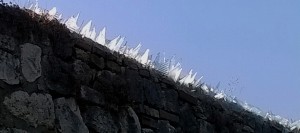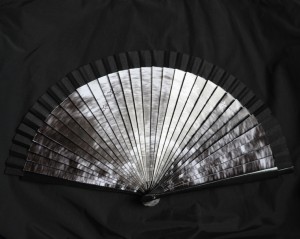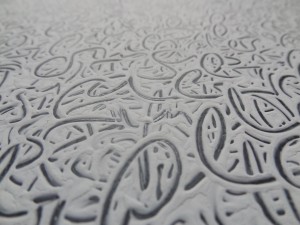dal 1 al 19 aprile 2019
Meccanismo psichico e psicosomatico, causato da fattori mentali quali lo stress e il conflitto, il disturbo di conversione dà luogo a fenomeni che esprimono chiaramente ciò che fino a quel momento è stato celato, invisibile ad occhi esterni. Sebbene il titolo della mostra sia in parte ironico e dal duplice significato, sono effettivamente invisibili al mondo le protagoniste dei dipinti di Rita Mandolini, invischiate in una materia densa, quella del nero: il non-colore per antonomasia, con la sua qualità assorbente, che esalta per contrasto la luminosità e che è divenuto, nella storia della pittura, un elemento determinante per la composizione e la spazialità. La scala dei toni di nero, con ripetute pennellate, conferisce lo spessore materico e la profondità dei riverberi, fra tratti lucidi e opachi. Il non-colore costruisce la forma, che appare sfuggente e gradualmente si trasfigura, dando corpo a un’immagine persistente e penetrante. Le immagini di suore, una quadreria di suore, in cui ogni dipinto è un ritratto. L’osservatore dev’essere avvezzo all’attesa, occorre qualche istante prima che lo sguardo si abitui alla reale percezione della superficie nera.
É l’oscurità, la condizione prediletta dall’artista. Il buio e i piccoli anditi: spazi intimi e nascosti, come i luoghi in cui ci si rifugia nell’infanzia. Ci troviamo in una dimensione privata e raccolta, ove si affacciano memorie sepolte, fra giochi e paure, evocate nella fotografia che ricorda il muretto della scuola sormontato da vetri taglienti. «I legami visivi ed emotivi che instauro con un luogo o una storia sono per me fondamentali nel dare forma a un’idea», scrive l’artista. In questo caso, l’esecuzione dei ritratti di suore si è dispiegata dal 2009 al 2019, un lasso di tempo in cui si colloca la visita al convento di Santa Rita, dove – nel racconto di Mandolini durante una conversazione – una suora le ha mostrato la “reliquia” di Yves Klein, devoto alla Santa, un prezioso scrigno contenente colori e oro dell’artista francese. Lo scrigno sembrava ambiguamente, ironicamente (e forse drammaticamente) simile a una trousse per il trucco femminile. Senza eufemismi né indulgenza, e in contrasto con l’apparente tranquillità emanata dai ritratti, lo sguardo si rivolge alle contraddizioni interiori sorte da proibizioni, inibizioni, conflitti, negazione della femminilità, segreti inconfessabili. Fronteggiano la quadreria due tradizionali simboli di femminilità: in Orpello (2017) appare un pettine, rappresentato a guisa di quelli dipinti da Diego Velàzquez, maestro nell’uso del nero; mentre un ventaglio, talismano di femminilità celata con frivolezza, è “decorato” con l’ecografia uterina dell’artista, mettendo in mostra un altro andito segreto, visibile nel suo aspetto fisico e crudo, spazio interno fra le interiora scelto come autoritratto. Il ventaglio conserva la forma originale, ma l’immagine è in attrito con la funzione dell’oggetto, che risulta quindi alterata così come avviene con la liquirizia, una massa strisciante di materia che invade il pavimento pur continuando a diffondere il caratteristico profumo che la rende così invitante.
Identità e interiorità si trovano in opposizione, o comunque in bilico sul filo di un labile confine, tra lo sguardo distaccato e la compassione (nel significato latino del sentimento di vicinanza). Ma si tratta anche del confine tra la forma (se così possiamo chiamare la cangiante epifania dei dipinti) e l’informe (il ventre sul ventaglio e la matassa dei cavi di liquirizia). «Mi diverte molto modellare, ma anche disfare», afferma l’artista. La forma vive dunque in uno stato sempre mutevole, in virtù della luce o della malleabilità della materia, anche grazie allo sguardo altrui.
Rita Mandolini.
Sono nata a Roma, dove vivo, lavoro e mi sono diplomata in pittura all’Accademia di Belle Arti. I legami visivi ed emotivi che instauro con un luogo o una storia sono per me fondamentali nel dare forma a un’idea. Ognuna richiede di essere espressa con un medium specifico.
Ho iniziato con la pittura, che utilizzo prevalentemente e accoglie ogni altro linguaggio o tecnica che possa mettere in discussione l’ovvietà dei rapporti tra apparenza, tratto, materia, visibilità. Cerco di mettere in atto una trasformazione poetica del luogo o del soggetto. Ho sperimentato la natura del limite lavorando su spazi circoscritti come l’interno del corpo e l’ambiente domestico, usati come palcoscenico del proprio dramma.
Sono attratta dalle potenzialità del nero, sempre diverso da sé, mutevole e cangiante. L’assenza di luce e colori mi ha sempre affascinato, fin dall’età in cui l’oscurità era un posto in cui rifugiarsi, capace di contenere segreti, idee e forme.
Lentezza e attesa mi appartengono. Ambienti domestici, memorie sepolte, spazi ristretti, intimi e nascosti nella semioscurità, sono i miei campi d’azione preferiti. Quando non c’è luce a sufficienza, si è costretti ad affinare i propri sensi, ad essere pazienti, in attesa che il nostro sguardo, prima disorientato, abiti con disinvoltura il nuovo spazio. E’ in quelle zone d’ombra, in cui lo sguardo è solo una parte del tutto, che io mi ritrovo.
Progetti recenti:
• “La linea d’ombra”, di Pasquale Polidori, a cura di Diletta Borromeo, Macro Asilo, Roma, 2019.
• “Fuori 8”, collettiva a cura di Carlo Gallerati e Noemi Pittaluga, Galleria Gallerati, Roma, 2019.
• “Spazio buio”, Ogni spazio buio è la camera oscura dell’infanzia, l’immagine l’oggetto fatale, progetto per la Black room del Macro, Roma, 2018.
• “Non ti faccio uscire non ti lascio entrare”, personale a cura di Noemi Pittaluga, Galleria Gallerati, Roma, 2018.
• “Contestare l’ovvio”, collettiva a cura di Helia Hamedani, Mlac La Sapienza Università, Roma, 2017.
• “Il sé allo specchio / autoritratti fotografici”, collettiva a cura di Giorgio Bonomi, Ass. Cult. Artefuoricentro, Roma, 2017.
• “Pezzi Unici III”, collettiva a cura di Noemi Pittaluga, Galleria Gallerati, Roma, 2016.
• “Muse ispiratrici per artiste ispirate”, collettiva a cura di Manuela De Leonardis, progetto per la stanza di
Jackeline Kennedy, Albergo Capitol, Crotone, 2015/2016.
• “Naked Lights”, progetto a cura da P.L.M. Piacentini e Ludovica Palmieri, Teatro Tor di Nona, Roma,
2015. “Radice”, azione; “Non puoi avere l’ultima parola”, installazione.
• “Dialoghi spuri in quattro atti”, Atto II, un progetto di Chiara Giorgetti, Sartoria Teatrale di Massimo
Poli, Firenze, 2015. “Dal soffitto non cadono fiori, l’acqua non sempre riflette”, installazione e video.
• Nero Roma, personale a cura di Roy Alexander Leblanc, Roy Alexander Art Gallery, Los Angeles, 2015.
PRESS RELEASE 8
Location AOCF58 – Galleria BRUNO LISI, via Flaminia 58 – Rome (line A, Flaminio)
Artist Rita Mandolini
Title Disturbo di conversione
Curated by Diletta Borromeo
Opening Monday, April 1st 2019, 6.30 pm
From April 1st to the 19th 2019
From Monday to Friday, 4.30 pm to 7 pm (closed on Saturdays and public holidays)
As a psychic and psychosomatic mechanism, caused by mental factors as stress and conflict, conversion disorder leads to phenomena that clearly reveal what had been hidden and invisible to the outside until that moment. Although the title of the exhibition is partly ironic and characterized by a dual significance, the protagonists in Rita Mandolini’s paintings are indeed invisible to the outside world, caught up in that thick matter that composes the colour black, the noncolour par excellence that, with its absorptive quality, exalts the light by contrast and which has become in the history of painting a key element for composition and spatiality. The scale of black hues, through multiple brush strokes, gives materic thickness and depth of reverberations, with both shiny and opaque sections. The noncolour shapes the form, which appears to be fleeing and gradually transforms itself, giving substance to an enduring and penetrating image. Images of nuns, a wall of paintings in which every picture is a portrait. The observer needs to know how to wait, we need a few moments before the eyes get used to the real perception of the black surface.
Darkness is the ideal condition of the artist. The absence of light and the small dark corners, intimate and secret places like the ones you usually hide in as a child. We find ourselves in a private and cosy dimension in which buried memories come to light through toys and fears, evoked in the photography that recalls the school wall covered with sharp glasses. As the artist claims: «The visual and emotional bonds that I establish with a place or a story are fundamental to me in giving some form to a concept». In this particular case, the execution of these portraits of nuns has been carried out from 2009 to 2019, a time lapse within which the artist visited the monastery of Santa Rita, where, as Mandolini said during a conversation, a nun showed her the ‘relic’ of Yves Klein, devotee of the saint, a precious treasure chest containing colours and gold belonging to the French artist. The chest ambiguously, ironically (and perhaps dramatically) looked like a make up bag. Without any euphemism or indulgence, and in contrast with the apparent calmness emanated by the portraits, the gaze addresses the internal contradictions arisen from prohibitions, inhibitions, conflicts, the negation of femininity, unspeakable secrets. Two traditional symbols of femininity face the group of paintings: in Orpello (2017) we see a comb, similar to those painted by Diego Velázquez, master at using the colour black; whereas a fan, talisman of a femininity concealed through frivolousness, is ‘garnished’ with the artist’s pelvic ultrasound, showing another secret nook, visible in its most physical and visceral aspect, internal space among the innards chosen as self-portrait. The fan preserves its original form but the image is in conflict with the function of the object, which turns out to be altered and malleable like liquorice, a crawling mass of matter that swarms into the floor, while continuing to spread out that typical fragrance which makes it so tempting.
Identity and inner reality are in opposition, or on precarious balance on the cord of a blurred boundary, between the detached gaze and the compassion (in its Latin meaning of empathy). But this is also a boundary between form (if we can define in this way the changing epiphany of the paintings) and formless (the womb on the fan and the bundle of liquorice sticks). «I really enjoy moulding, but also undoing», the artist says. Therefore, form lives in an always-changeable state, by virtue of light or malleability of the matter, also thanks to other people’s gaze.
Diletta Borromeo
Rita Mandolini.
I was born in Rome, where I took a degree in painting at the Accademia di Belle Arti, and where I currently live and work. The visual and emotional bonds that I establish with a place or a story are fundamental to me in giving some form to a concept. Each one of them needs to be expressed through a specific medium.
I began practising with painting, the medium I use most and which embraces every other language or technique capable of questioning the obviousness of the relations among appearance, trait, matter, visibility. I try to give rise to a poetic transformation of the place or of the subject. I have experienced the nature of the limit, working on delimited spaces like the interior of the human body and the domestic environment, used as stage for one’s own drama.
I am attracted by the potentialities of the colour black, which is always different from itself, variable and changing. The absence of light and colours always fascinated me, since that very age when darkness was a place to hide in, capable of keeping secrets, ideas and forms.
Slowness and waiting belong to me. Domestic environments, buried memories, spaces which are narrow, intimate and hidden in the semi-obscurity are my favourite spheres of action. When there isn’t enough light, we need to improve our senses, to be patient, in wait for our gaze, initially disoriented, to inhabit comfortably the new space. It is exactly in those shadow areas, in which our gaze is but a part of the whole, that I really find myself.
Recent projects:
• “La linea d’ombra”, by Pasquale Polidori, curated by Diletta Borromeo, Macro Asilo, Rome, 2019.
• “Fuori 8”, collective exhibition curated by Carlo Gallerati and Noemi Pittaluga, Galleria Gallerati, Rome, 2019.
• “Spazio buio”, Ogni spazio buio è la camera oscura dell’infanzia, l’immagine l’oggetto fatale, project for the Black room of Macro museum, Rome, 2018.
• “Non ti faccio uscire non ti lascio entrare”, solo exhibition curated by Noemi Pittaluga, Galleria Gallerati, Rome, 2018.
• “Contestare l’ovvio”, collective exhibition curated by Helia Hamedani, Mlac La Sapienza Università, Rome, 2017.
• “Il sé allo specchio / autoritratti fotografici”, collective exhibition curated by Giorgio Bonomi, Cultural Councillor Artefuoricentro, Rome, 2017.
• “Pezzi Unici III”, collective exhibition curated by Noemi Pittaluga, Galleria Gallerati, Rome, 2016.
• “Muse ispiratrici per artiste ispirate”, collective exhibition curated by Manuela De Leonardis, project for Jacqueline Kennedy’s room, Albergo Capitol, Crotone, 2015/2016.
• “Naked Lights”, project curated by P.L.M. Piacentini and Ludovica Palmieri, Teatro Tor di Nona, Rome,
2015. “Radice”, action; “Non puoi avere l’ultima parola”, installation.
• “Dialoghi spuri in quattro atti”, Atto II, project by Chiara Giorgetti, Sartoria Teatrale di Massimo
Poli, Florence, 2015. “Dal soffitto non cadono fiori, l’acqua non sempre riflette”, installation and video.
• Nero Roma, solo exhibition curated by Roy Alexander Leblanc, Roy Alexander Art Gallery, Los Angeles, 2015.


